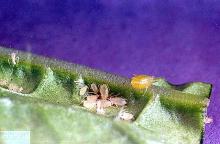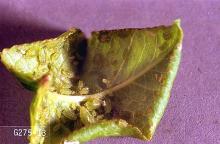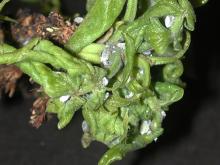Includes Myzus persicae and other species
See:
Pest description and crop damage Several aphid species attack peaches, including the green peach aphid, mealy plum aphid, and rusty plum aphid. Green peach aphid adults have a black head and thorax and a green body. Nymphs are yellowish-green. Adults of the mealy plum aphid are pale bluish green with a white, powdery coating. The rusty plum aphid is rusty brown or deep purple with white bands on the legs.
The aphid feed initially on the shoot tips, which on young trees can cause stunting and malformation of the tips. On older trees, fruit set may be reduced in subsequent years if populations are high, and honeydew production can cause sooty mold problems on fruit. Green peach aphid is a bigger problem on nectarines and on summer vegetable crops, for which it is an important vector of some virus diseases.
Biology and life history The aphid overwinter as eggs in crevices and twigs. The eggs hatch near budbreak, and the nymphs feed on unopened buds and the underside of the leaves. The leaves curl and protect the aphid as they feed. After two to three generations, winged forms are produced that migrate to summer hosts which include weeds, ornamental plants, vegetables, or plants of the mustard family (in the case of black cherry aphid). After several more generations, the winged forms migrate back in the fall to the tree fruit to mate and lay the overwintering eggs.
Scouting and thresholds Begin observing shoots prior to budbreak, as management is best done early and while the aphid are small.





